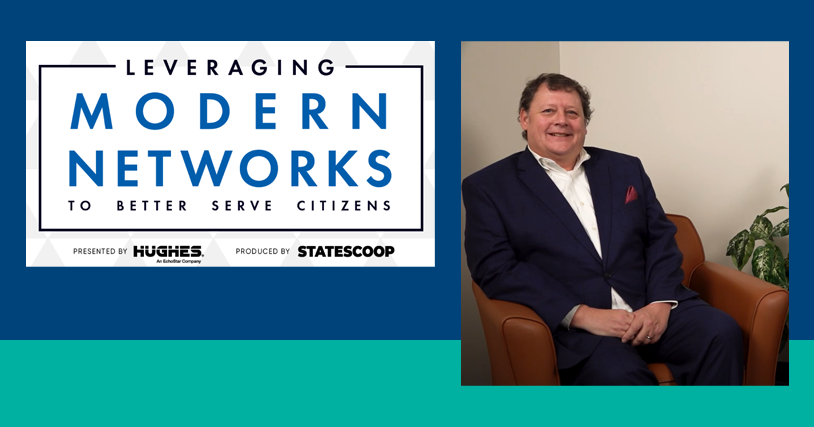
Network performance is a big indicator of how reliably state and local agencies can serve their constituents. In StateScoop’s video spotlight series “Leveraging Modern Networks to Better Serve Citizens,” state government IT officials discuss how they build greater agility, security and resiliency into their network infrastructures.
In a recent segment, James Clevenger, director of Government Sales at Hughes, discussed the unique challenges facing state and local governments and how agencies are leveraging modern capabilities to improve connectivity for their constituents. Here are some highlights from the interview.
What is it about state and local government networks that make them unique?
By definition, state networks are intrastate -- all within the same state -- versus federal or enterprise networks that cross state lines or even international borders. What that meant for a long time is that the local exchange carriers were the only ones that could provide service for these types of networks. IP networks have changed that. Now states have many different solutions and options at their fingertips, enabling them to benefit from cheaper and more reliable bandwidth just as enterprises and federal network customers do.
Other than that, states have similar Wide Area Network needs as federal and even enterprise customers. States need secure, reliable, fast as possible networks.
Even within a state, you can have different locations that require different types of connectivity, correct?
Some larger states, like Texas and California, are bigger than some countries. Their locations can be in urban environments or in rural environments. Their networks need to be able to support all of their locations—from urban, to suburban to rural. That type of multi-access environment is where Hughes excels, supporting connectivity in both the urban “NFL Cities” as well as the most remote and rural locations.
Let's talk about some specific solutions, like Software-defined Wide Area Networking, or SD-WAN. How does SD-WAN benefit state agencies, public servants, and citizens?
SD-WAN networks are now smarter and more reliable, with the ability to route traffic based on application type or network status. That means that state network managers can separate and prioritize mission critical applications like 9-1-1 calls or emergency alerts from less critical traffic, such as online research or email correspondence.
For example, Hughes provides the Commonwealth of Pennsylvania with remote access and WAN capabilities that allow police officers to do their job no matter where they are—such as on a highway when they need to access information about a license plate during a traffic stop.
What's on the horizon? What should state agencies be looking for next?
State agencies are being asked to support various types of locations and needs from a networking perspective. However, for agencies, how they achieve network connectivity – whether it's a fiber, satellite or cellular circuit – matters less than the assurance that they have access to the information they need when they need it. Low earth orbit, or LEO, capabilities coming online soon will add another access method that state agencies should be ready to integrate into their networks.
Since multi-access environments are where the industry is headed, flexibility in state purchasing agreements and contracts will be essential. Multiple provider awards offer that flexibility while also spurring competition among providers—which ultimately benefits the buyers. States should also make sure to have technology refresh clauses built into their contracts, to adapt and incorporate new technologies as they become available.
Watch the full interview here, where James talks more about the impact of managed solutions, like Managed Broadband, and how digital signage can benefit constituents and employees. Other segments in the StateScoop video series include interviews with Texas CTO John Hoffman; Deputy Executive Director/CTO of Georgia Technical Authority Dmitry Kagansky; Pennsylvania CTO Jason Hebbe; and New York CTO and Executive Deputy CIO Rajiv Rao.